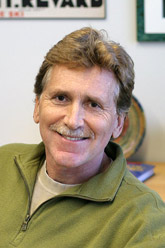

Tuesday, March 16, 2010
SLAC Today is
available online at:
http://today.slac.stanford.edu
In this issue:
Team to Survey First Third of Cosmic Time
Stöhr to Speak on LCLS at Stanford April 12 and 13
Workshop Highlights SLAC and Stanford Photon Science
 |
 |
|
Tuesday, March 16, 2010 |
Team to Survey First Third of Cosmic TimeThe Wide Field Camera 3, installed onto the Hubble Space Telescope last May, will play an important role in the upcoming Cosmology Survey Multi-Cycle Treasury Program. (Photo courtesy of NASA/STScI.)
A team of more than 100 investigators, including Risa Wechsler of the Kavli Institute for Particle Astrophysics and Cosmology, have been awarded 902 orbits—or a total of about three and a half months—of observing time on the Hubble Space Telescope, the most time ever awarded to a single project. With this observing time, which will begin later this year, astronomers on the Cosmology Survey Multi-Cycle Treasury Program will peer deep into the universe to document the early history of star formation and galaxy evolution. By imaging more than 250,000 distant galaxies, the project will provide the first comprehensive view of the structure and assembly of galaxies over the first third of cosmic time. It will also yield crucial data on the earliest stages in the formation of supermassive black holes and find distant supernovae important for understanding dark energy and the accelerating expansion of the universe. "My main role on the team will be to provide theoretical context based on our understanding of the evolution of structure over this epoch of the Universe," Wechsler said. Currently our models for star formation in early galaxies are relatively unconstrained, and these data will be very important for informing our models. This is a new and exciting field that's been made possible by Hubble's new infrared camera, the Wide Field Camera 3. It's really amazing that we can see galaxies so far back in time!"  Stöhr to Speak on LCLS April 12 and 13 at StanfordJoachim Stöhr, director of the Linac Coherent Light Source, will deliver the Stanford Department of Physics' 2010 Robert Hofstadter Memorial Lectures on April 12 and 13, on campus. Both talks are free and open to the public. The Hofstadter lectures were established in memory of Nobel Prize-winning physicist Robert Hofstadter, who served on the Stanford physics faculty from 1950 until his death in 1990. Stöhr's first talk, "The Light Fantastic: Birth of the X-Ray Laser and a New Era of Science," is scheduled for 8 p.m. Monday, April 12, in Room 105 of Building 320 at Stanford. His talk will trace the 20-year history of the creation of LCLS and describe how the facility is now being used by scientists worldwide. His second talk, "Birth of the X-Ray Laser: Movies of the Dynamic Worlds of Atoms and Electrons," will describe the evolution of modern X-ray sources, culminating in the creation of LCLS. It is scheduled for 4:15 p.m. Tuesday, April 13, in the Hewlett Teaching Center, Room 201. Read more in the Stanford Report... Workshop Highlights SLAC and Stanford Photon ScienceSome of the workshop attendees enjoy the sunshine outside the
Stanford quad. (Photo by Julie Karceski.)
Making a brief but enlightening stop on the way to this week's American Physical Society meeting in Portland, Oregon, a group of scientists from around the world came to the Stanford University last week for the Theoretical Institute of Photon Science Workshop. Hosted by Tom Devereaux from the Stanford Institute for Materials and Energy Science, a joint SLAC/Stanford institute, the workshop focused on light-source based materials science. The event ran from March 10 to 12 and featured talks on new materials with promising electrical and magnetic properties, including superconductors, colossal magnetoresistance materials, and topological insulators. "This was a way to create a community, a network, for people interested in SIMES and SLAC," Devereaux said. "The idea was to bring minds together to discuss and explore the exciting new developments in instrumentation and materials science and to form collaborations." To help fund the workshop, Devereaux used funding from Laboratory Directed Research and Development program, which designates money for innovative ideas and special projects outside established research programs. The workshop attendees and presenters were a combination of Devereaux's collaborators, former graduate students and post docs. About fifteen collaborators visited from outside institutions, and nearly fifty packed in for the first day of talks on topological insulators. Nobel Laureate Albert Fert from France was among the presenters. Many of the talks focused on what can be learned about materials with tools like Stanford Synchrotron Radiation Lightsource and the Linac Coherent Light Source at SLAC. "SSRL and LCLS can probe states of matter on extremely small length and time scales," Devereaux said. "SIMES works in connection with these facilities to explore what can be learned about the fundamental science of novel materials and new phases of matter." |
Events
Access (see all)
Announcements
|
|
| | ||
|
|
||
 <%
Response.AddHeader "Last-modified", getArticleDate()
'Response.AddHeader "Last-modified","Mon, 01 Sep 1997 01:03:33 GMT"
'Monday, December 06, 2010
%>
<%
Response.AddHeader "Last-modified", getArticleDate()
'Response.AddHeader "Last-modified","Mon, 01 Sep 1997 01:03:33 GMT"
'Monday, December 06, 2010
%>View online at http://today.slac.stanford.edu/. |
||